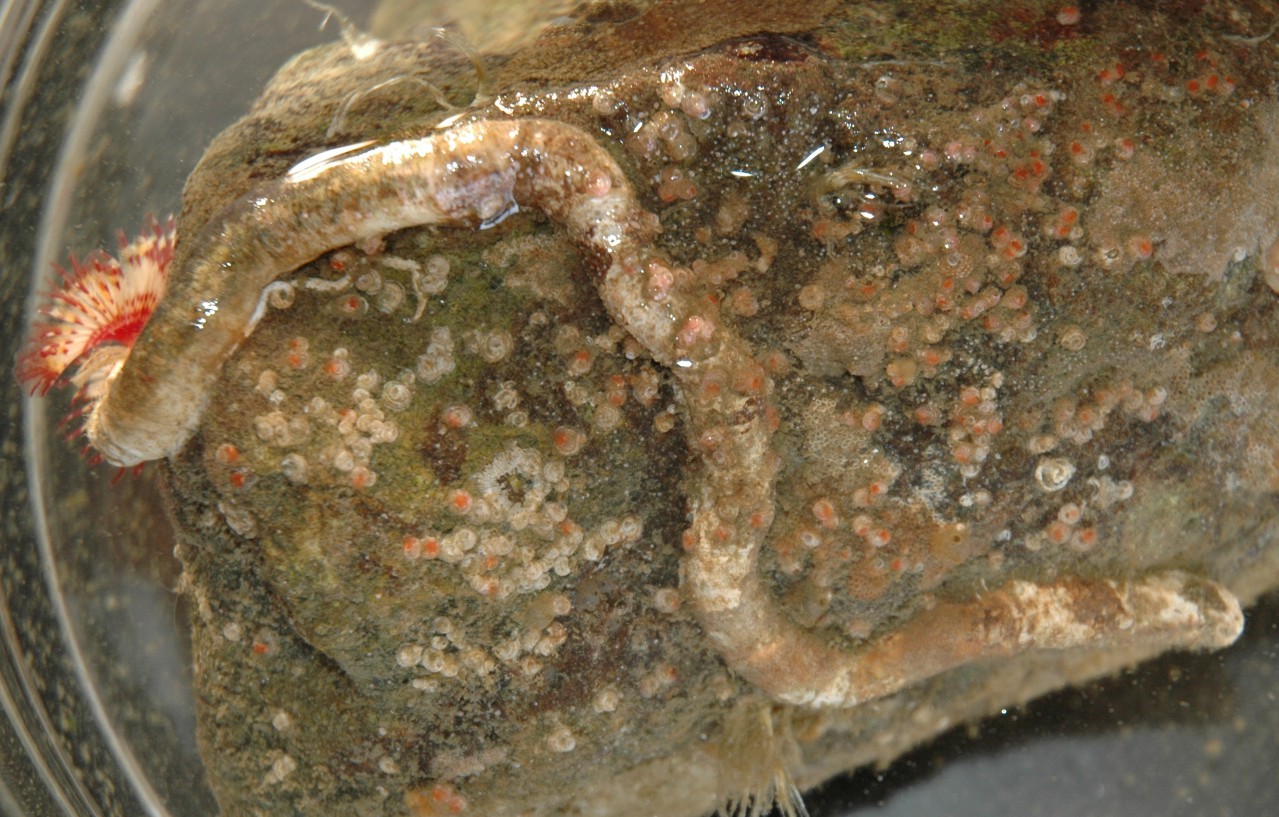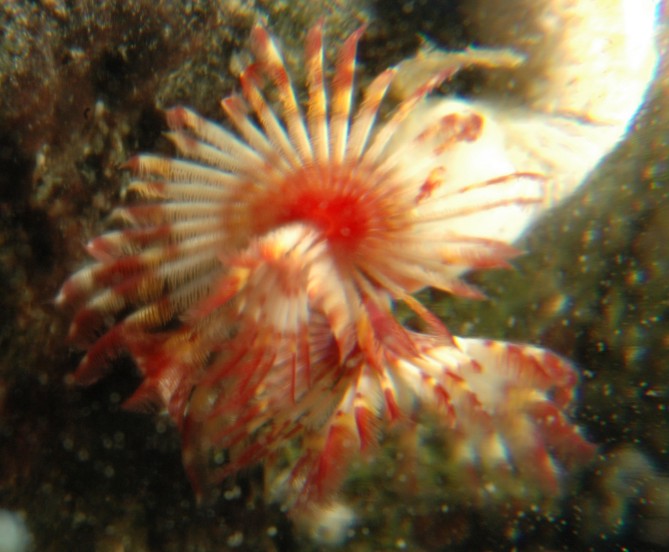Serpula columbiana Johnson, 1901Common name(s): Calcareous tubeworm, Plume worm, Fan worm, Limy tube worm, Red tube worm |
|
| Synonyms: Serpula vermicularis |  |
| Phylum Annelida
Class Polychaeta Order Sabellida Family Serpulidae |
|
| A large Serpula columbiana on a rock picked up subtidally near Rosario. Total tube length about 12 cm and nearly 1 cm diameter. | |
| (Photo by: Dave Cowles) | |
How to Distinguish from Similar Species: This very common species is the only local serpulid with the reddish plumes and a funnel-shaped, symmetrical operculum with no protuberances. It is also the only species of large serpulid found in our area. It was previously synonymized with S. vermicularis, a European species, but is now considered a separate species. Spirorbids are small and have a strongly coiled tube.
Geographical Range: Cosmopollitan: Pacific, Atlantic, and Indian oceans, Mediterranean Sea, North Sea. Alaska to Baja California on our coast, and in the western Pacific in Siberia down to Japan.
Depth Range: Intertidal to 100 m
Habitat: Attached to the undersides of rocks in the intertidal, on floats, or on any surface of subtidal rocks.
Biology/Natural History: This species has two white calcium sacs near the midventral line on the posterior end of the peristomium. The sacs store calcium from a pair of glands which open on the "ventral shields" which are wide glandular pads on the ventral side of the anterior thoracic segments. The ventral shields probably secrete organic material and use this, combined with the calcium, to form a paste from which the tube is made. The tube appears to be shaped by the ventral shields and by a collar which is just behind the head. The tubes are made of both calcite and aragonite. The operculum is cartilaginous and secretes mucus, which seems to be both antibiotic and prevents fouling. The blood of this species, as with most species of serpulids and sabellids, contains chlorocruorin. Chlorocruorin has a very strong affinity for carbon monoxide--570 times as much as human hemoglobin has. This may partly explain why this worm may settle on some seaweed such as Fucus but seems to avoid Nereocystis. The pneumocysts of Nereocystis are inflated with carbon monoxide, which would probably be strongly toxic to these worms. The circulatory system of this species is unusual. It has a ventral blood vessel which moves blood posteriorly as is normally seen in annelids, but blood moves anteriorly through a sinus that surrounds the gut. Blood flow into peripheral parts is tidal.
The animal is a filter feeder. Predators include Pisaster ochraceous. Sexes are separate. Eggs and sperm are released into the water.
Serpulids
feed by extending featherlike
radioles,
which also
function as gills. The blood circulation within the radiole
is unusual. Instead of having one-way flow through afferent
and efferent
vessels within the radiole,
there is a single branchial vessel which blood flows in and out
of.
Serpulids
possess
giant nerve fibers
running down their body which allows them to retract rapidly into their
tube if disturbed.
| Return to: | |||
| Main Page | Alphabetic Index | Systematic Index | Glossary |
References:
Dichotomous Keys:Flora and Fairbanks, 1966 (as S. vermicularis)
Kozloff 1987, 1996 (as S. vermicularis)
Carlton, 2007
General References:
Carefoot,
1977 (as S. vermicularis)
Gotshall,
1994 (as S. vermicularis)
Harbo,
1999 (as S. vermicularis)
Johnson
and Snook, 1955
Kozloff,
1993 (as S. vermicularis)
McConnaughey
and McConnaughey, 1985 (as S. vermicularis)
Morris
et al., 1980 (as S. vermicularis)
Niesen,
1994 (as S. vermicularis)
Niesen,
1997 (as S. vermicularis)
Ricketts
et al., 1985 (as S. vermicularis)
Sept,
1999 (as S. vermicularis)
Scientific
Articles:
Kupriyanova, Elena K., 1999. The taxonomic status of Serpula
CF Columbiana
Johnson, 1901
from the American and Asian coasts of the North Pacific ocean
(Polychaeta:Serpulidae).
Ophelia 50 pp. 21-34
Web sites:
General Notes and Observations: Locations, abundances, unusual behaviors:

Anterior appendages include the abundant radioles
seen here. Behind the radioles
to the bottom left the lighter red, funnel-shaped operculum
can be seen.

This tiny individual, with a tube less than 1/2 cm long, is attached
to a bryozoan. Note the coiling of the tube in tiny
individuals such
as this. The funnel-shaped operculum
is visible to the left of the radioles.
The gray, forklike object projecting down to the left from one of the
coils is a tiny phoronid worm about 2 mm long. Cilia on the
worm's
forked lophophore are beating strongly.
Note: Leslie Harris, a polychaete specialist from the Natural History
Museum of Los Angeles County, suggests that this tiny individual is
probably
a different species.
Authors and Editors of Page:
Dave Cowles (2006): Created original page